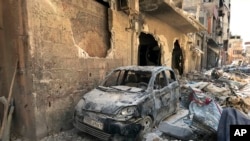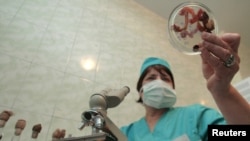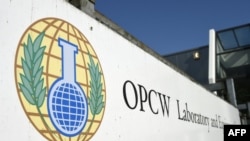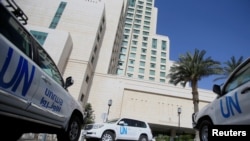Since invading Ukraine on February 24, Russia has consistently spread the false claim that the United States is secretly funding “biolabs” and the development of biological weapons in Ukraine.
The head of Russia's State Duma Defense Committee, Andrei Kartapolov, further played up “Washington’s military-biological programs” on December 5.
"Despite the ratification of the Chemical Weapons Convention, the United States is the only country in the world that still has not completed getting rid of them,” Kartapolov said during at the Parliamentary Assembly of the Collective Security Treaty Organization, a six-country alliance that includes Russia.
“And, by the way, it has the newest technologies in service in this sphere.”
That is false.
While the United States has not yet fully eradicated its chemical weapons stockpile, it is not alone in possessing chemical weapons.
Russia, which “officially” completed the destruction of its chemical weapons arsenal in 2017, maintains a chemical weapons capacity, and has actually deployed chemical weapons at home and abroad.
The same goes for North Korea and Syria, which have close ties with Russia.
The Chemical Weapons Convention (CWC) obliges state parties “to chemically disarm” by destroying all stockpiles they produced, including those “abandoned on the territory of other state parties.”
Only four states – Egypt, Israel, North Korea and South Sudan – are not party to the convention, which is administered by the Organization for the Prohibition of Chemical Weapons (OPCW).
Albania, India, Iraq, Libya, Syria, the United States, Russia and an anonymous state “widely believed to be South Korea,” all declared they had chemical weapons stockpiles when they joined the CWC, according to the Arms Control Association (ACA), a nonprofit that advocates for global arms control policies.
All those countries except the United States have destroyed their declared arsenals. The key word is “declared,” which we’ll get to briefly.
In August 2018, Paul F. Walker, director for environmental sustainability at Green Cross International, an environmental organization headquartered in Geneva, explained to Polygraph.info some of the technical complications in eliminating the U.S. stockpiles compared to Russia’s, which you can read here.
It is also worth noting that the U.S. and Russia use different definitions of “destruction.” In the U.S. it is a complete process, while in Russia destruction does not include dealing with large volumes of highly toxic waste.
Beyond that distinction, Russia and Syria clearly have maintained an undeclared chemical weapons capacity. And they have used it to deadly effect.
Russia infamously employed the Soviet-era nerve agent Novichok in the March 2018 attack on former Russian military intelligence officer Sergei Skripal and his daughter Yulia Skripal, in Salisbury, England. The Skripals survived, but the attack resulted in the collateral poisoning death of British national Dawn Sturgess.
Following the Salisbury attack, the OPCW added several Novichok agents to its list of Schedule 1 substances – chemicals which have little or no use outside of chemical warfare.
Then, in August 2020, Russian opposition leader Alexey Navalny was poisoned with Novichok while traveling in Tomsk, Russia. An investigation by the news site Bellingcat and Russia’s The Insider (in cooperation with Der Spiegel and CNN) traced the attack to a team from Russia’s Federal Security Service.
Although the Novichok variant used against Navalny was not included on the updated list of Schedule 1 substances, the OPCW told Polygraph.info in a written statement that “all toxic chemicals and their precursors, except when used for purposes permitted by the CWC in specified quantities, are chemical weapons,” and thus banned under the convention.
In March, Gregory Koblentz, director of the Biodefense Graduate Program at George Mason University, told CNN that Russia’s use of Novichok “is a clear indicator that the Russian chemical weapons program has continued in some way.”
Syria joined the CWC in September 2013. In January 2016, the OPCW confirmed that Damascus had destroyed all of its declared chemical weapons. Yet, the Syrian government has been linked to multiple chemical weapons attacks against its own people since declaring stockpiles destroyed.
In July 2020, the OPCW said it had concluded “there are reasonable grounds to believe that the Syrian Arab Republic used chemical weapons,” specifically chlorine and sarin gas, and condemned the use of those weapons.
“[T]he use of such chemical weapons by the Syrian Arab Republic, by direct implication, establishes that the Syrian Arab Republic failed to declare and destroy all of its chemical weapons and chemical weapons production facilities, and demands that the Syrian Arab Republic immediately cease all use of chemical weapons,” the OPCW said.
In April 2021, the OPCW suspended several of the Syrian Arab Republic’s rights and privileges due to those violations.
Analysts believe North Korea has amassed large quantities of chemical and biological weapons and is capable of manufacturing thousands of tons of chemical weapons annually.
North Korea has been implicated in the state-sponsored assassination of Kim Jong Nam, the half-brother of North Korea’s leader Kim Jong Un, using VX, a deadly nerve agent that is odorless and tasteless.
Soon after the attack at Kuala Lumpur airport, South Korean intelligence officials identified four of the suspects who flew out of Malaysia as North Korean spies.
In 2018, a panel of U.N. experts concluded that North Korea was sending supplies to Syria that could help Damascus reestablish its chemical weapons program.
The United States did produce tens of thousands of tons of chemical weapons from World War I to 1968 as a deterrent, according to the U.S. government’s Centers for Disease Control and Prevention. Those weapons were never used in battle.
In October, the OPCW’s director-general noted the “unprecedented efforts and progress of the United States to eliminate its chemical weapons stockpile.”
He added that the “strong cooperation” of the U.S. “to support the OPCW’s verification at its chemical weapons destruction facilities strengthen the Organization’s efforts to permanently eradicate the scourge of chemical weapons.”
The U.S. is slated to finish destroying its remaining chemical weapons stocks by September 2023. In April, the U.S. Defense Department said it had reached a milestone with destruction of the last rocket containing VX.








